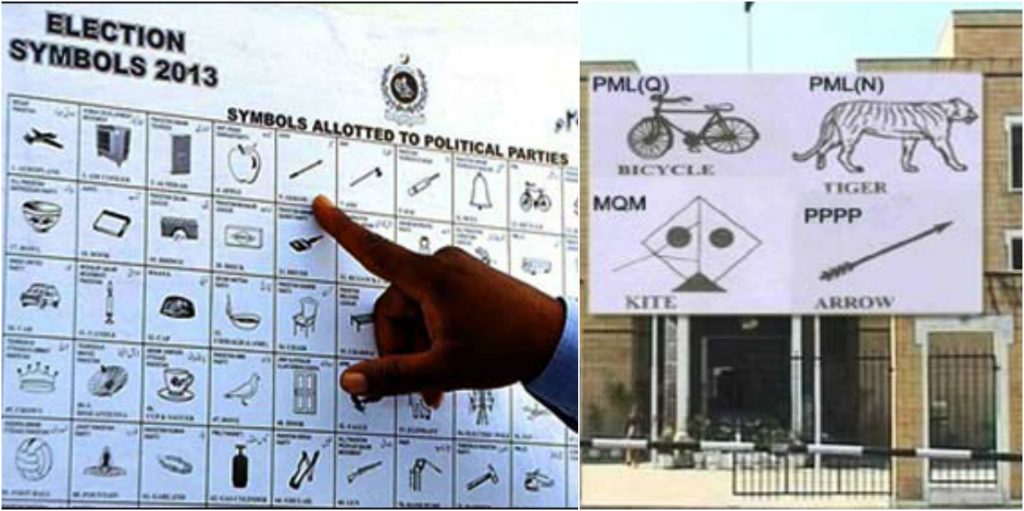Disclaimer*: The articles shared under 'Your Voice' section are sent to us by contributors and we neither confirm nor deny the authenticity of any facts stated below. Parhlo News will not be liable for any false, inaccurate, inappropriate or incomplete information presented on the website. Read our disclaimer.
This post is also available in: English (الإنجليزية) اردو (الأردية)
Each election, I wonder what is the rationale behind allotting election symbols to a political party or a candidate. If one needs to identify with a candidate, shouldn’t a picture of the candidate him/herself, or a party flag for that matter, be enough. The curious thing is, these symbols hardly have anything to do with the party ideology or manifesto, and they are hardly consistent with a candidate’s personality (read “sher”), the only notable exception being PTI, perhaps. Some were just assigned randomly on a party’s first outing to contest and they have held on to them religiously. Yet others like Jamaat e Islami have settled on whatever they have been assigned, I can recall at least 3 in my own lifetime.
It’s a very similar culture in a more mature democracy next door, election symbols are more than a formality. A few years ago, around 2012, a politician from the Indian city of Hyderabad was breaking news in India due to some controversial remarks. While looking up on him online, I came across a video of the gentleman, Akbarudin Awaisi, addressing a rally in his stronghold of Hyderabad’s old quarters, making a gesture to his supporters. It was as if he was flying an imaginary kite. It was only then I noticed the “kite” on the giant screen put up for the rally. Akbarudin Awaisi’s party, AIMIM’s, election symbol is a kite. As a Karachiite, being all too familiar with the kite, I couldn’t help but wonder; do politicians giving controversial statements have something to do with the kite as an election symbol?
Here is a list of political parties from Pakistan and India who have contested on the same or at least similar election symbols.
Kite (Patang):
Muttahida Qaumi Movement (MQM) and All India Majlis e Ittehadul Muslimeen (AIMIM)
What is one thing in common in Hyderabad of Sindh and Telangana? They both have been strongholds of the Patang parties. Muhajir nationalist MQM and Muslim nationalist AIMIM, both have had convincing electoral victories in their own respective Hyderabad, and they both have the kite as their election symbol. While both parties are hardly similar in their nationalist rhetoric, some similarities are uncanny. Leaders of both parties are known to cause an outrage in their own countries, both have been labeled as traitors and conspiring with the enemy, the last decade has been progressively spent in attempts to expand out of traditional bases and while factions have emerged, the core has remained intact. AIMIM, probably, is bound to leave a more lasting legacy due to its roots in undivided India, while MQM has a more visible affinity with violence, AIMIM doesn’t even close.
Bicycle:
Pakistan Muslim League – Quaid e Azam, or PML Q, and Uttar Pradesh’s Samajwadi Party.
Both parties are a result of splits in their “mother” parties and just one of countless factions that have emerged over the years; Q League from Muslim League and SP from Janata Dal, both have their strongholds in the most populous provinces of their respective countries, Punjab and UP. While both parties have considerately retained the leadership within one family, there is hardly any common ground between the two parties’ ideologies. PML Q’s leaders, Chaudhary brothers, are known to prosper under the wings of dictators, while SP’s Yadav dynasty has maintained its image of a party of scheduled and backward castes and minorities, especially Muslims.
Lantern:
Awami National Party (ANP) and Rashtrya Janata Dal (RJD).
Pakhtoon nationalist ANP and formerly socialist, Lalu Prasad Yadav’s, RJD, both started off as left of center parties. But over time, both parties have not only wandered off from their past, they have also receded to try and maintain power in majorly one province; ANP in Khyber Pakhtunkhwa and RJD in Bihar. Like PML Q and SP, they too are offshoots of former larger ideological parties; ANP was formerly National Awami Party, a multi ethnic club of leftists and revolutionaries, while RJD is from “Janata Pariwar”, like SP. Interestingly, politicians of both parties have been accused of similar crimes while they have been in power, namely corruption, kidnapping for extortion and drug trafficking.
Teer (Arrow):
Pakistan People (PPP) and Janata Dal United (JDU).
The two parties wielding the arrow as their symbol have hardly anything in common, except the left of center past of both the parties. Both have roots in the troubled, yet anti-establishment politics of the late ‘60s and ‘70s. But JDU, like RJD and SP, is just one of many factions of the former Janata Dal and did not become a force to reckon with until the early ‘90s. On the other hand, PPP, whose heart and soul now resides in its Teer, has been in power at federal and provincial levels, while JDU has managed to come to power only in Bihar. At least in one case, the election symbol has brought differing fortunes.
Weighing Scale:
Jamaat e Islami (JI) and Shiromani Akali Dal (SAD)
The only two self-proclaimed religious parties on the list, although SAD has come too far from its religious past. Both parties started off as apolitical, reactionary movements to reform their own respective communities, according to their own ideas. But it is indeed strange how an Islamist and a Sikh centric party landed with similar election symbol. Also, both parties have previously formed alliances with other right wing parties; JI by being part of IJI and MMA and SAD by being a coalition partner with BJP in NDA. But JI has maintained and takes pride in its democratic structure while SAD has gradually degenerated into a Badal family club.







